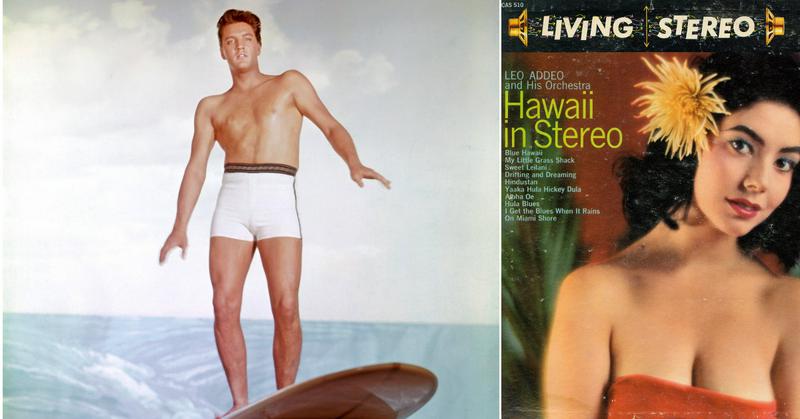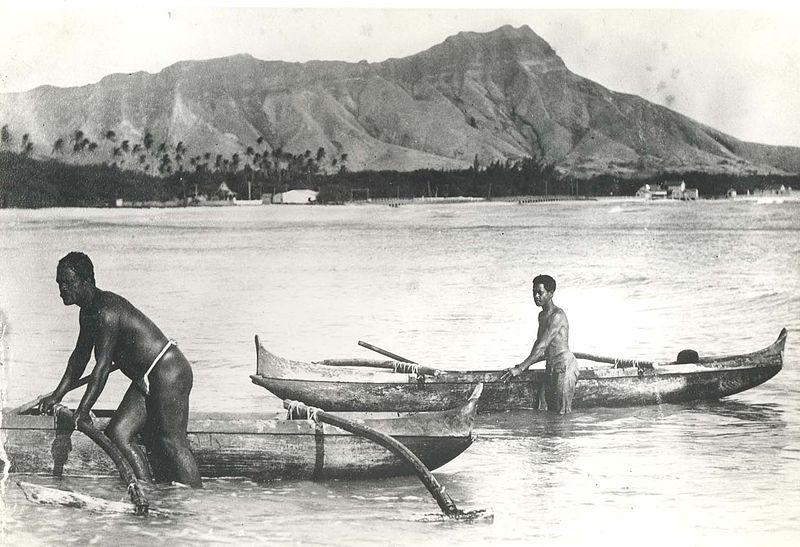1959: When Congress Approved Hawaii As A State, And Hollywood Followed Suit
By | March 9, 2020

Mainland Americans have been traveling to the exotic island of Hawaii for fun in the sun since the early 1800s but when Congress approved Hawaii to be a state in 1959 pop culture changed forever. As America’s 50th state Hawaii became a fixation not only for tourists but Hollywood. In the decade following Hawaii’s induction into statehood pop culture found a new muse in the isolated cluster of islands in the pacific. A romanticized idea of Hawaii spread thanks to the films of Elvis, tiki culture, exotica, and even Pan-Am. In many ways this pineapple and palm tree explosion expanded the horizons of many land locked Americans while turning the islands into one massive resort regardless of what locals wanted.
Locals only

The initial settlers on the Hawaiian Islands date back to the eighth century when Polynesian explorers made their way through the pacific and touched down on the fertile island of aloha. Americans didn’t start poking around Hawaii until the 18th century when traders looked to the islands in search of sandalwood. At the time Hawaii was ruled by its own monarchy, first the Kamehameha dynasty then followed by the Kalākaua Dynasty. On July 17, 1893, Sanford B. Dole, a descendant of the American missionary community to Hawaii and major proponent of the westernization of Hawaiian culture organized a coup an overthrew the Hawaiian government in an effort that was backed by U.S. businesses. On July 4th, 1894. Sanford Dole became the first president of the Republic of Hawaii and in 1898 the islands were annexed by President William McKinley.
My annexed Hawaii

Once Hawaii was annexed it remained in a state of non-statehood for more than 60 years. During that time Hawaii became a territory with Dole as its first governor. It’s possible that Hawaii could have become a state much earlier than 1959 but sugarcane processing companies found that it was more financially advantageous to exploit the cheap, foreign labor of the island. As a territory companies didn’t have to worry about paying a federal minimum wage or worrying about benefits (whatever version of benefits existed in the early 20th century). Following the attack on Pearl Harbor by Imperial Japan on December 7, 1941 eyes turned to Hawaii with many considering the area where the Arizona sank a defacto American monument.
Hawaii finally became a state in 1959

Hawaii should have been a state long before 1959, but after active campaigns by locals who wanted to receive full congressional support the aloha state was paired up with Alaska and they were both brought into the Union to balance one another out - at the time lawmakers believed that Hawaii would be a Republican strong hold and that Alaska would swing Democratic. When Hawaii was finally admitted to the States the tropical lifestyle washed over contiguous Americans. Film, music, style, and a general way of life took over America for the next decade, influencing the culture in ways that we’re still feeling today.
Tiki culture became a way of life

Hawaii’s initiation into the United States followed on the heels of soldiers returning home from World War II. Many of these vets had been stationed in the South Pacific where they encountered the laid back Polynesian lifestyle. In an attempt to recreate the drinks and vibes of the South Pacific tiki culture experienced a mid-century explosion. When Hawaii became a state many veterans traveled to the island where and found the tropical local to be amenable to their chill lifestyle. Donn Beach opened Don the Beachcomber as well as the Dagger Bar while non-Beach affiliated tiki bars popped up across the island and even stateside. Drinks like the Blue Hawaii and the Zombie became staples along with the “exotica” music movement that went hand in hand with tiki bars across the country.
Pan-Am made it easy to get your island on

It only took three days for Pan American to offer jet service to Hawaii following its move to statehood. This ease of travel completely changed Hawaii forever. According to an article in the LA Times about the service, “The islands, which had been the playground of well-heeled visitors, most of whom traveled by ship, began welcoming middle-class travelers.”
The Pan-Am strengthened travel didn’t just lead to an increase of tourism, but the state’s industry as well. By 1964 construction spending had increased 20 percent from ’63 - a financial boon that was helped by the $27 million high-rise project on Waikiki Beach. In 1960 the Chicago Tribune guessed at this increase in business in an article by the Travel Editor that read, “Hotels are rising on every hand. Apartment buildings are springing up like mushrooms. Stores and offices fill land that not so long ago was garden.”
Hollywood goes Hawaii

Mainland America’s fascination with Hawaii increased with the 1961 movie musical Blue Hawaii, starring the one and only Elvis Presley. The film followed Elvis as he played an Army veteran returning from the war to croon for tourists, get his surf on, and marry his girlfriend while working for her parent’s tourism agency. It introduced land locked audiences to ukulele tinged pop, and helped raise the profile of tiki culture and the lounge music of the 1950s. Blue Hawaii was the first of many Hollywood goes Hawaii movies to play in theaters in the 1960s. Films like Girls! Girls! Girls! Paradise, Hawaiian Style, and Gidget Goes Hawaii all continued the trend with The King appearing three out of four of the movies mentioned.
Surf culture exploded

Thanks to the proliferation of surf culture in the Hollywood goes Hawaiian films everyone wanted to surf. There were plenty of waves in Southern California, but thanks to gorgeous vistas on display in movies like Blue Hawaii surfers flocked to Waikiki Beach to paddle out into the crystal blue waters of Hawaii. The island’s surf ready beaches were most prominently featured in the cult classic documentary from 1966 The Endless Summer, which showcased the beauty of the waves and the way in which surfers communed with the ocean. By the end of the ‘60s Hollywood’s fascination with Hawaii dimmed but it never went away. Tiki culture can still be found in modern rockabilly music and the island continues to make appearances in films and television.
